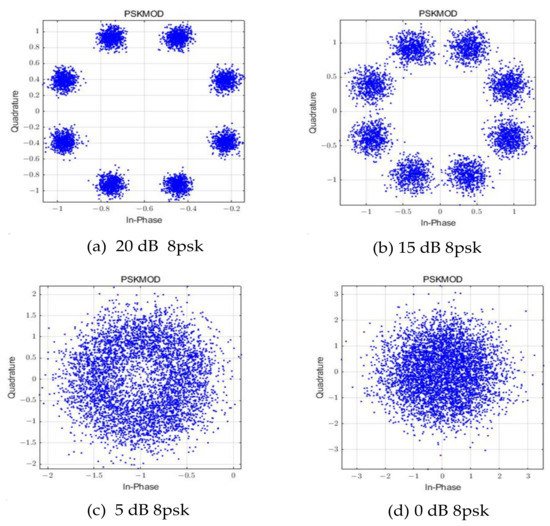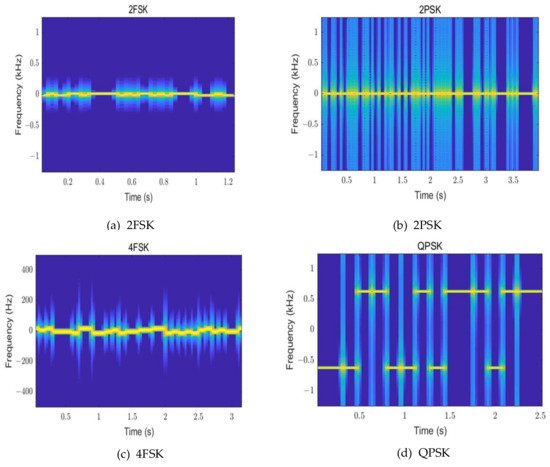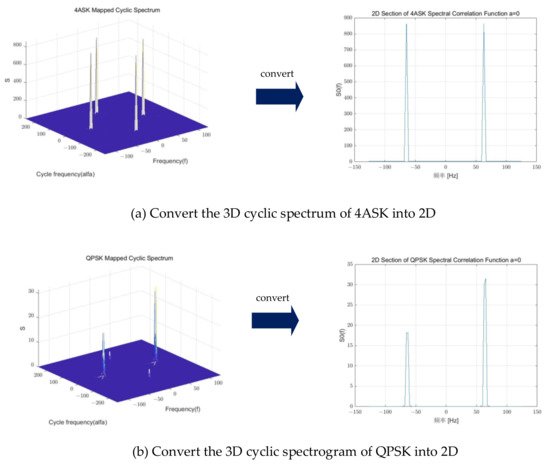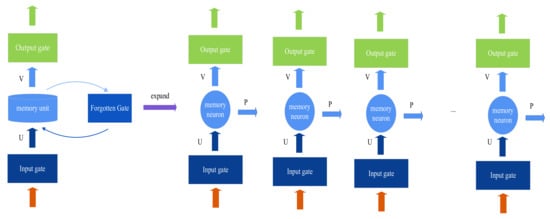Your browser does not fully support modern features. Please upgrade for a smoother experience.
Please note this is an old version of this entry, which may differ significantly from the current revision.
深度学习是一种强大的人工智能技术,可以从大量数据中学习特征,拟合非线性网络,因此在计算机视觉、自然语言处理、语音识别等领域得到了广泛的应用,取得了巨大的成功。由于移动通信网络可以非常快地生成大量不同类型的数据,相关研究人员已将深度学习应用于通信领域,为通信技术的发展带来了机遇,例如无线通信中的信号调制,识别可以用深度学习技术来完成,并且基于深度学习的调制识别方法比传统方法具有更好的鲁棒性和更高的准确性。 抗菌素谱分析方法。在深度学习中,有许多优秀的神经网络,如CNN,RNN等。其中,CNN擅长处理图像数据,RNN擅长处理序列信号,因此CNN和RNN在AMR中得到了广泛的应用。我们将在这篇文章中详细介绍神经网络在AMR中的应用。
- CNN
- deep learning
- RNNs
- modulation recognition
- intelligent signal processing
1. 卷积神经网络在调制识别中的应用
1.1. 卷积神经网络
卷积神经网络(CNN)是最流行和最成功的深度学习架构之一,它由多个卷积层、池化层和全连接层组成,其结构图如图1所示。其中,卷积层可以提取输入数据的不同特征,池化层可以对卷积后的高维特征进行降级以提高计算速度,全连接层可以将先前提取的局部特征组合成全局特征,最终根据特征完成分类。

图 1.卷积神经网络结构。
CNN是图像处理的理想选择,因为它可以使用卷积从图像中准确地提取特征信息。因此,学者们在识别调制信号的类型时,通常会将信号处理成星座图、时频图等二维图像,然后利用卷积层从图像中提取信号的特征,分类由全连接层完成。另一方面,CNN也广泛用于文本和信号,因此许多学者使用CNN直接从信号中提取特征。
1.2. 基于卷积神经网络的调制识别方法
- 1.
-
一种基于CNN的二维图像识别方法.
将信号转换为2D图像,然后使用CNN识别调制是非常流行的,因此我们将在本节中介绍这种方法。
(1) 星座图
星座图是对信号投影到正交矢量空间的图形见解,其维度由特定的调制类型决定。二维星座图是迄今为止最常见的,它可以反映不同调制类型的不同特征。本文显示了图7中8PSK信号在20 dB、15 dB、5 dB和0 dB下的星座图。从图2可以看出,星座图的特征在高信噪比下比较明显,在低信噪比下不太明显。因此,一些学者会将单通道星座图转换为三通道彩色星座图,以提高识别率,从而可以达到更好的效果,因此星座图经常用于调制识别。

图 2.不同信噪比下8PSK的星座图。
彭胜利等.[1]将复杂信号转换为星座图,并将两种流行的CNN模型(AlexNet和谷歌网络)应用于复杂信号的识别,并设计了基于CNN的调制识别算法。最后,实验表明,当信噪比大于6 dB时,该算法对8种调制信号的识别率达到95%以上,优于传统的支持向量机。但是,当信噪比小于1 dB时,模型的识别精度小于80%。可以看出,低信噪比下的识别精度有待提高。
为了提高识别分类的准确性,田旭[2]将星座图处理为带有彩色阴影的热图。然后,使用典型的CNN模型,即VGG16,VGG19,InceptionV3,Xception和ResNet50来识别六种调制方法的星座热图。其中,ResNet50具有最佳的分类精度,准确率可以达到95%以上。然而,当信噪比降至2 dB时,识别精度降至80%,因此该方法仅适用于高信噪比环境。
由于缺乏对MIMO-OFDM系统中基于DL的AMR的相关研究,作者[3]针对MIMO-OFDM系统的调制识别问题,提出了一系列星座多模态特征网络(SC-MFNet)。SC-MFNet网络由四部分组成,包括基于Conv1DNet的特征提取模块、基于高效网络的星座特征提取模块、多模态特征融合模块和全连接分类器。作者将5个调制信号(BPSK、QPSK、8PSK、16 QAM和32 QAM)的波形图和分段累积星座图输入到SC-MFNet网络中,网络提取信号波形图和星座图的特征,并融合特征。最终分类实验表明,当信噪比为0 dB时,SC-MFNet的识别精度为95%。
(2) 眼图
眼图是由示波器上累积的一系列数字信号显示的波形,可以反映数字信号的整体特性。不同调制信号的眼图特性不同,因此可以将信号转换为眼图,然后利用深度学习网络模型提取眼图中的特征,完成调制识别。将调制信号转换为眼图是调制识别过程中的重要步骤。复习文献后,最常用的转换方法有三种:一是使用示波器专用的眼图生成模块将调制信号转换为相应的眼图[4];二是使用MATLAB中的眼图功能生成眼图;第三是研究人员需要编写自己的程序来完成眼图的转换。由于眼图本身是由示波器的余辉效应生成的,因此上面提到的第一种方法在生成眼图时会更准确。由于实验条件的限制,本文利用MATLAB中的眼图功能将QPSK、8PSK、16PSK、4QAM、16QAM和256QAM信号转换为眼图,如图3所示。

Figure 3. Eye diagram of modulated signals.
The authors of [5] demonstrated preliminary results of deep learning for modulation identification through eye diagrams of signals. The paper first convolves the I and Q eye maps of the signal, secondly connects the I and Q eye maps, then performs maximum pooling, and finally experimentally verifies that the model can achieve a 100% recognition rate for OQPSK as well as BPSK. The recognition rate of 16 QAM is less than 80%.
The authors of [6] considered that the original eye diagram did not consider the signal aggregation degree at a specific position, so they enhanced the eye diagram. The authors use the enhanced signal eye diagram as the input to the neural network, and then extract and map features of different dimensions using a multi-input CNN model. Experiments show that the recognition accuracy of the model for BPSK, QPSK, OQPSK, 8PSK, and 16APSK is close to 100% at 2 dB, but the recognition accuracy for 64 QAM, 32 QAM, and 16 QAM is low. Therefore, it is necessary to further improve the intraclass recognition of modulated signal accuracy.
Dan. W et al. [4] proposed a CNN-based optical signal modulation recognition and classification algorithm. The author uses the eye pattern generation module of the oscilloscope to generate four modulated optical signals (return-to-zero on-off keying (RZ-OOK), non-return-to-zero keying (NRZ-OOK), RZ-differential phase shift keying (RZ-DPSK), and four-pulse amplitude modulation (4PAM) are converted into eye diagrams, and then CNN is used to learn the features of the eye diagrams and complete the classification. The recognition rate of the four modulation methods is close to 100%.
(3) Time-frequency diagram
If only the characteristics of the signal in the time and frequency domains are analyzed, the characteristics of the signal may be lost. Therefore, to observe the relevant characteristics of the signal more thoroughly, scholars will perform time-frequency analysis of the signal, such as using wavelet transform and other methods, such as converting the signal to a time-frequency map and extracting the features from the time-frequency map. Therefore, it is also a popular method to use deep learning to extract time-frequency map features to complete modulation recognition. We have drawn the time-frequency diagrams of 2FSK, 4FSK, 2PSK, and 4PSK signals in Figure 4, and we can see that different modulation signals have different time-frequency diagrams.

Figure 4. Time-frequency diagram of modulation signal.
The authors of [7] used neural networks to process time-frequency images of radar signals to identify the modulation types of radar signals. This paper first uses complex wavelet transform to obtain the time-frequency image of the signal, and then uses image cropping, grayscale, adaptive filter normalization, and other steps to enhance the time-frequency image. The results show that when the signal-to-noise ratio is −7 dB, the recognition rate reaches more than 92%, which fully proves that the time-frequency diagram of the signal can well reflect the characteristics of the modulated signal. The author also proposed the Sep-ResNet model for recognition. After comparison, the Sep-ResNet model is better than the ResNet50 and VGG networks.
The authors of [8] proposed an LPI radar signal recognition method based on dual-channel CNN and feature fusion. The authors used the wavelet transform method to convert the signal into a time-frequency map, and the time-frequency map was processed in grayscale. Subsequently, it was inputted into the two-channel CNN model, which can extract two features, the oriented gradient (HOG) and the depth feature histogram, from the signal time-frequency map and finally fuse the two features and classify them. The classification method has a signal-to-noise ratio of 6 dB, and the recognition rate can reach more than 95%.
The authors of [9] proposed a modulation and identification method of impulse noise communication signals based on fractional low-order Choi–Williams distribution and CNN, aiming at the low recognition rate of a communication signal in non-Gaussian noise. Feature extraction was performed, and then FLO-CWD used to transform the signal time-frequency map by inputting the transformed time-frequency map into the improved CNN for the second feature extraction and classification. The recognition rate of this method reaches 95% at 4 dB. However, this method only recognizes signals of 2ASK, 2FSK, and 2PSK modulation methods and does not know the recognition rate of other modulation methods. Therefore, if we want to apply this method to actual communication systems, we need to continue research and optimization.
(4) Circulation spectrogram
A cyclic spectrum has good anti-noise performance, so it is often used to analyze signals in environments with large noise interference. The 3D graph output by the cyclic spectrum can give an intuitive impression, and the signal can be further analyzed by the cross-sectional view of the 3D graph in different directions. In order to further visualize the cyclic spectrogram of the modulated signal, this paper uses MATLAB to draw the three-dimensional cyclic spectrogram of QPSK and 4ASK and intercept the two-dimensional part when the cyclic frequency alpha is equal to 0, as shown in Figure 5.

图 5.QPSK 和 4ASK 信号的图形构造。
2019年,作者[10]针对星座图在低信噪比下性能差、识别率低、适应阶段差等问题进行了改进,提出了一种基于创新CNN和递归频谱图的调制识别方法。笔者首先将信号的三维循环频谱映射为二维,再以二维循环频谱为数据集。然后使用改进的CNN来提取循环频谱的特征。最后,软最大层用于成功识别8种调制模式。
作者[11]提出采用深度学习算法对信号进行循环频谱图处理,以识别二次调制信号。作者使用 AlexNet、vgg16、vgg19 和 resnet18 来识别七个调制信号(蓝牙、QPSK、2FSK、无线频谱、二方点和 DS-BPSK)的二维循环频谱图像。实验结果表明,VGG19和ResNet18的识别精度较高,但BFSK-PM和BPSK-PM的混淆率较高。
(5) 振幅直方图
信号的振幅直方图可以表示信号的幅度与不同振幅的采样点数之间的关系。不同调制方法的幅度直方图差异较大,如图6所示,说明不同调制方法的幅度直方图都是不同的形状。

图 6.调制信号的幅度直方图。
作者[12],提出了CNN的新方案。基于信号幅度直方图的联合OSNR监测和MFI。笔者利用常模算法(CMA)在均衡后得到调制信号样本,绘制振幅直方图(Ahs),然后利用卷积神经网络一种基于VGG的设计,提取振幅直方图的特征进行分类和识别。经过2500次训练,QPSK、8-QAM、16QAM的识别率达到100%,说明CNN可以根据信号的直方图识别信号的调制类型。
作者[13]提出了一种基于通信信号循环累积的多层神经网络调制模式识别方法。作者使用改进的CNN提取MPSK和MQAM循环频谱图中表示的信号特征,然后使用软最大层完成分类。该算法在−5~5 dB的信噪比环境中可实现92%的识别精度。
- 2.
-
一种基于CNN的信号序列识别方法.
除了基于CNN的信号二维图像识别方法外,一些学者还利用CNN直接提取信号序列中的特征并完成分类。因此,本节将介绍基于CNN的信号序列识别方法。
(1) 智商序列
S. Hong等人提出了一种基于DL的AMR算法来识别正交频分复用(OFDM)系统中的信号[14].作者使用卷积神经网络来训练OFDM信号的智商样本。通过实验可以看出,当信噪比为10dB时,正确分类概率高于90%,但当信噪比低于10dB时,识别精度迅速下降。
为了使CNN能够处理少量数据,作者[15]提出了一种数据增强调制识别方法。作者首先根据输入IQ信号计算幅度、相位和频率,并将其作为最基本的信号特征。其次,根据星座图中调制信号的分布重新排列信号的相序,从而获得新的特征。然后,获得信号的高阶光谱信息,以提供新的识别线索。最后,将IQ信号、信号的振幅频率相位、重序IQ序列、重序幅度频率相位、信号的高阶频谱输入到改进的CNN中进行分类和识别。实验结果表明,该算法的平均识别率达到95%以上。但是,这种方法的特征提取过程相对复杂,不利于其在多变的通信环境中的使用。禹。W等人将基于DL的AMR算法应用于多输入多输出(MIMO)系统,并在他们的工作中[16]他们提出了一种基于 CNN 的零强迫 (ZF) 均衡 AMR 方法。其中,采埃孚均衡可以提高信道状态信息(CSI)下接收信号的信噪比,提高调制辨识的准确性。因此,作者将接收到的信号和CSI输入到采埃孚均衡中,进行矢量化,最后将它们输入到CNN中进行分类。通过实验可以看出,当信噪比为5 dB时,基于CNN的采埃孚均衡AMR算法的识别精度达到90%以上,优于基于ANN和高阶累积的传统算法。胡恩-泰等人[17]提出了一种三维MIMO-OFDM卷积神经网络(MONet),能够在多输入多输出正交频分复用(MIMO-OFDM)系统中实现高效的AMR。天线内部和天线之间的相关底层特征可以通过网络的立方卷积滤波器在多尺度信号下提取。通过实验仿真,MONet在0 dB的条件下可以达到95%的识别精度。
(2) 高阶累积物
早在1992年就进行了基于高阶累积体的信号调制识别研究,当时作者[18]使用高阶累积物作为相关特征,并使用决策树做出判断,从而识别调制模式。随后,许多学者开始使用高阶累积物作为调制分类的特征。[19][20][21]并取得了良好的效果。深度学习发展后,一些学者将深度学习与高阶累积算法相结合,研究了一种新的AMR算法。
王毅提出了一种基于CNN的一氧化碳AMR方法[22].作者使用 CNN 提取所有天线数据集中信号的高阶累积特征,并识别子结果。将所有子结果合并,最后使用决策规则(直接投票和加权投票)完成分类。实验表明,当信噪比大于0 dB时,算法的识别精度可以达到100%,但在−5 dB时,识别率仅为82%。因此,有必要进一步提高低信噪比下的识别率。
从以上文献调查可以看出,由于CNN更适合从图像中提取信息,因此关于利用CNN直接提取信号序列特征的研究并不多。相对而言,RNN直接从信号序列中提取特征的能力比CNN更强。因此,本文将在下一节中介绍基于RNN的调制识别算法。
2. 递归神经网络在调制识别中的应用
2.1. 递归神经网络
递归神经网络 (RNN) 与具有前馈连接的典型多层网络不同。RNN 通过递归连接的概念进行扩展,以将信息反馈到前一层(或同一层)。其结构如图7所示。RNN 的输入是不同时刻的数据。首先,信息将从信号的那一刻开始输入。输入门决定此时刻的信息是否输入到记忆神经元中。输出门决定是否输出此时刻的信息。遗忘之门决定了这一刻的信息是否被遗忘。如果不忘记,可以将其传输到下一刻,并循环该过程,直到处理整个输入信号。根据上述特点,可以知道RNN非常擅长处理序列信号,如时间序列、文本序列、音频数据等。[23].通信信号是随时间变化的信号,因此一些学者开始使用RNN来处理通信信号[24].因此,本节介绍RNN在调制识别中的应用。

图 7.循环神经网络的结构图。
2.2. 基于递归神经网络的调制识别
自动调制识别工作非常依赖于信号的特性。对于不同类型的特征,提取和分类方法也不同。在之前的内容中提到,使用CNN更容易提取信号的二维图像中的特征,但对于其他形式的特征,CNN的提取和分类效果就不那么好了。例如,雷达信号中的脉冲重复间隔(PRI)特征不利于使用CNN进行提取和分类,因为信号的PRI将极大地阻碍CNN的在线应用[25].随后,一些学者证明,LSTM模型可以比CNN模型更好地提取PRI特征。[26].
2020年,作者[27]针对PRI的序列特性,提出了一种将注意机制与GRU相结合的模型,用于识别雷达信号的调制类型。该模型可以在存在高比例的缺失和杂散脉冲的情况下提高识别率。本文建议使用单热向量来表示PRI序列,然后减小序列的维数并将其输入到基于注意力的GRU模型中,这可以保存PRI序列中包含的顺序模式,最后通过GRU输出。本文建议使用单热向量来表示PRI序列,然后减小序列的维数并将其输入到基于注意力的GRU模型中,这可以保存PRI序列中包含的顺序模式,最后通过GRU输出。
受LSTM模型中势层节点能够保留信息的动态时域特性的启发,一些学者提出了一种基于LSTM的低信噪比调制识别方法。[28].这项工作使用LSTM网络来构建信噪比分类器,去噪自动编码器,最后是识别分类器。信噪比分类器由三层LSTM层和一个全连接层组成,可根据设定的阈值将信号分为低信噪比信号和高信噪比信号。去噪自动编码器由五个双向LSTM层组成,可以对信噪比低的信号进行去噪。最后,设计了一种基于LSTM的调制识别结构。实验结果表明,基于LSTM的调制识别模型在信噪比为0~8 dB时,平均识别率可达90%以上,但信噪比为−10 dB~−2 dB时识别速率仍然很低。
S. Wei等人使用结合自我注意机制和双向LSTM的模型来识别雷达信号的调制模式。[29].该方法在低信噪比下可准确识别8类雷达调制信号,−10 dB时识别率高达95%。实验表明,该模型的识别精度优于中国人类发展网络、德尔肯网络、赛克-CNN和赛克网络。景庆峰等.[30]设计了一种基于LSTM和GRU的端到端调制辨识方法,可直接从采样信号中获取调制类型。实验结果表明,笔者提出的端到端调制识别方法,每种类型的调制信号都能达到90%的识别率。为了解决 CNN 和 RNN 在提取信号特征时的局部依赖性约束,W. Kong 等人提出了一种基于变压器的连接顺序神经网络结构 (ctdnn)[31].首先,笔者利用卷积层将信号的时域序列映射到高维空间,然后利用变压器编码器完成信号的特征提取,最后利用全连接层完成信号分类。实验表明,该模型能很好地完成10个调制信号的分类。
本文总结了过去5年基于RNN的调制辨识方法,见表1。由于RNN更容易从序列信号中提取信息,因此将信号的IQ序列输入到RNN中进行识别更有利于提高识别精度。
表 1.基于循环神经网络的调制识别算法综述.
| 作者 | 年 | 输入信号 | 型 | 调制信号类型 | 识别精度 |
|---|---|---|---|---|---|
| 洪斌等人[32] | 2017 | 智商信号 | 双层格鲁 | 无线电话区调频、钢筋水泥基、钢筋水泥基、钢 塑胶、高速钢、8平方米、16QAM、64QAM、联邦经济核电厂、中央公共广播电台、太平洋汽车工业区4 |
91% (−4 分贝) |
| 金华等[33] | 2019 | IQ信号的幅度相位 | 断续器 | 8太平洋、亚太铁路、亚太经社会公共广播电台、全球核材料市场协调会、4、16年期、2016年期、64、卡塔尔公共铁路公司、太平洋岛屿国家铁路公司、世界和平银行 | 80% (6 分贝) |
| 王燕等.[34] | 2020 | 智商信号 | 汇丰财经网 | 16QAM, 32QAM, 北京公共广播电台, QPSK, 8PSK, 太平洋汽车, 中央人民银行, 广核电, 调频, SSB | 86% (0 分贝) |
| 杨汉等.[35] | 2021 | 信号的极坐标表示 | 美国国税局 + 语言材料 | 北京公共广播电台、 QPSK, 8PSK, 16QAM, 64QAM, GFSK, CPFSK, 4PAM, WBFM, AM–DSB | 90% (0 分贝) |
| Liu et al. [36] | 2021 | IQ signal | DCN-BiLSTM | AM-DSB, AM-SSB, WBFM, BPSK, 8PSK, QPSK, CPFSK, GFSK, PAM4, 16QAM, 64QAM | 90% (4 dB) |
| Zi. et al. [37] | 2022 | IQ signal | LSTM | 8PSK, AM-DSB, AM-SSB, BPSK, CPFSK, GFSK, PAM4, QAM16, QAM64, QPSK, WBFM |
90% (8 dB) |
| V.N.Senthil Kumaran [38] | 2022 | Original signal | EDL-MSC (GRU + Bi LSTM + SSAE) | 8PSK, BPSK, 16QAM, 64QAM, QPSK | 92% (−4 dB) |
| UdayaDampage [39] | 2022 | IQ signal | LSTM + Bi LSTM | BPSK, QPSK, 16QAM, 64QAM, 256QAM | 90% (0 dB) |
| P. Ghasemzadeh [40] | 2022 | IQ signal | S-QRNN | OOK, 4ASK, 8ASK, BPSK, QPSK, 8PSK, 16PSK, 32PSK, 16APSK, 32APSK, 64APSK, 128APSK, 16QAM et | 90% (5 dB) |
3. Application of Combination Neural Network in Modulation Recognition
根据前面的描述,CNN具有很强的图像信息处理能力,RNN在直接处理IQ信号时具有出色的性能。因此,一些学者将CNN和RNN结合起来,形成了CLDNN模型。[41],而CLDNN充分发挥了这两种模式的优势,进一步提高了调制识别的精度。此后,越来越多的学者致力于研究组合神经网络在调制识别中的应用。在本节中,我们总结了基于组合网络的调制识别方法。
王晖提出了一个由信息提示多流模块(SCMS)和视觉提示识别模块(VCD)组成的MCF网络。[42].网络实现了信号的IQ、AΦ和信号星座的并行特征提取。SCMS模块提取IQ信号和AΦ信号的特征,并使用VCD从星座中提取信号的特征。最后,对提取的特征进行融合和分类。作者在实验过程中将主频网络与CM+CNN、高新网、低频闪和长联网络模型进行了比较。结果表明,MCF网络的识别精度更高。当信噪比大于0 dB时,识别精度接近100%。
作者[43]提出了一个新的基于深度学习的注意力协作框架,其中包括CNN,RNN和GAN网络。其中,采用ACGAN对原始数据进行扩展,然后分别利用CNN和RNN提取信号的时空特征。最后,使用GAMP融合信号的空间和时间属性,并使用完全连接的层进行分类。实验表明,本文提出的注意合作框架在0 dB时可以识别11种调制信号,精度在90%以上。识别准确率优于VGG、网络、谷歌网络和CLDNN。作者[44]在他们的工作中提出了一个由浅卷积网络,GRU和DNN网络组成的CGDNet网络结构。其中,采用浅层卷积网络和GRU提取IQ序列信号的特征,DNN完成分类任务。在实验中,作者使用无线ML2016.10a和无线电ML2016.10b数据集来验证CGDNet结构的性能。在识别RadioML2016.10a调制数据集时,在0 dB时可以达到90%以上的识别精度;当识别RadioML2016.10b调制数据集时,它可以在18 dB时实现90%以上的识别精度。
[45]的作者提出了一种基于卷积长短期深度神经网络(CLDNN)的调制识别算法。CLDNN网络结构由四层卷积层、四层池层、两层LSTM层和两层全连接层组成。实验表明,CLDNN模型对11种调制信号的平均识别率达到90.8%,能够更好地识别QAM16和QAM64。
近年来,基于组合网络的调制辨识方法越来越流行,许多学者致力于研究更可靠的AMR组合网络。表2总结了近年来基于组合网络的调制辨识方法。
表 2.基于组合神经网络的调制识别算法综述.
| 作者 | 年 | 输入信号 | 型 | 调制信号类型 | 识别精度 |
|---|---|---|---|---|---|
| B. 唐等人[46]] | 2018 | 轮廓星座图 | 美国有线电视新闻网 + 甘 | 4ASK, BPSK, OQPSK, 8PSK, 16QAM, 32QAM, 64QAM | 100% (−2 分贝) |
| 刘霞等[47]] | 2020 | 智商序列,循环频谱 | 美国有线电视新闻网 + 格鲁 | 2个公共电话, 2个磁盘阵列, 2个快速通道, 4个公共电话, 4个磁盘阵列, 16个季度, 64个季度 | 100% (0 分贝) |
| 许俊等[48]] | 2021 | 智商序列 | 麦克尔登(美国有线电视新闻网 + 伦敦语言广播电台 + FC) | 世界边境地区议会、非洲-地区服务局、阿姆-苏丹中央银行、北京公共广播电台、中央公共技术研究中心、GFSK、4-帕姆、 16-QAM、64-QAM、QPSK和8PSK |
90% (0 分贝) |
| 蒋克等[49]] | 2021 | 智商序列 | 美国有线电视新闻网 + 毕氏语言空间站 + 关注 | 2个硬盘, 4个磁盘阵列, 宽带均衡, QPSK, 8个公钥适配器, 64QAM | 93.14% (10 分贝) |
| 段建斌等[50]] | 2021 | 原始信号 | 麦克布勒 (美国有线电视新闻网 + 毕氏语言空间站 + 关注) | 8太平洋、上午-DSB、北京公共消费和城市经济核电、中央人民会议、GFSK、第四次方、第16季度、第六十四届、卡塔尔公共铁路公司、世界羽联 | 93% (0 分贝) |
| 梁志[51]] | 2021 | 时频图 | ResNeXt WSL(ResNeXt + Attention) | 8太平洋社会主义共和国、北京公共广播电台、非洲人民银行、 QPSK、QAM16、QAM64、中央人民会议、全球公共伙伴关系、太平洋岛屿国家伙伴关系、太平洋-太平洋岛屿国家集团和 世界羽联, |
90% (0 分贝) |
| 张世昌等[52]] | 2022 | 采样信号 | 美国国家新闻网(CNN + Bi GRU + 南非国防军) | AM-DSB, AM-SSB, WBFM. 8太平洋夏令克,北京公共公共经济伙伴关系,中央人民经济共同体,GFSK, 4太平洋汽车,16QAM,64QAM,QPSK |
84% (0 分贝) |
| 张伟等[53]] | 2022 | 采样信号 | 格鲁 + 美国有线电视新闻网 | 北京人民进步银行, QPSK, BFSK, QFSK, 16QAM, 64QAM, 对外直接贸易商 | 99.45%(真实通道) |
| 邹乙等[54]] | 2022 | 智商序列 | ASCLDNN (注意 + CLDNN) | 北京人民社会、8PSK、中央人民银行、全球公共经济伙伴关系、GFSK、PAM4、16、QAM64、QPSK、AM-DSB、AM-SSB、无线双侧边疆 | 90% (0 分贝) |
| 白杰等[55]] | 2022 | 智商序列和 GAF 图像 | 美国有线电视新闻网(复杂价值网络 + ResNet50) | 2FSK, AM, DSB, FM, 对外直接投资, QAM16, QPSK, SSB | 91% (−10 分贝) |
This entry is adapted from the peer-reviewed paper 10.3390/electronics11172764
References
- Peng, S.; Jiang, H.; Wang, H.; Alwageed, H.; Zhou, Y.; Sebdani, M.; Yao, Y. Modulation Classification Based on Signal Constella-tion Diagrams and Deep Learning. IEEE Trans. Neural Netw. Learn. Syst. 2019, 30, 718–727.
- Tian, X.; Chen, C. Modulation Pattern Recognition Based on Resnet50 Neural Network. In Proceedings of the 2019 IEEE 2nd International Conference on Information Communication and Signal Processing (ICICSP), Weihai, China, 28–30 September 2019; pp. 34–38.
- An, Z.; Zhang, T.; Shen, M.; De Carvalho, E.; Ma, B.; Yi, C.; Song, T. Series-Constellation Feature Based Blind Modulation Recognition for Beyond 5G MIMO-OFDM Systems with Channel Fading. IEEE Trans. Cogn. Commun. Netw. 2022, 8, 793–811.
- Wang, D.; Zhang, M.; Li, Z.; Li, J.; Fu, M.; Cui, Y.; Chen, X. Modulation Format Recognition and OSNR Estimation Using CNN-Based Deep Learning. IEEE Photonics Technol. Lett. 2017, 29, 1667–1670.
- Li, Z.; Zha, X. Modulation Recognition Based on IQ-eyes Diagrams and Deep Learning. In Proceedings of the 2019 IEEE 5th International Conference on Computer and Communications (ICCC), Chengdu, China, 6–9 December 2019; pp. 1570–1574.
- Zha, X.; Peng, H.; Qin, X.; Li, G.; Yang, S. A Deep Learning Framework for Signal Detection and Modulation Classification. Sensors 2019, 19, 4042.
- Mao, Y.; Ren, W.; Yang, Z. Radar Signal Modulation Recognition Based on Sep-ResNet. Sensors 2021, 21, 7474.
- Quan, D.; Tang, Z.; Wang, X.; Zhai, W.; Qu, C. LPI Radar Signal Recognition Based on Dual-Channel CNN and Feature Fusion. Symmetry 2022, 14, 570.
- Tian, X.; Sun, X.; Yu, X.; Li, X. Modulation Pattern Recognition of Communication Signals Based on Fractional Low-Order Choi-Williams Distribution and Convolutional Neural Network in Impulsive Noise Environment. In Proceedings of the 2019 IEEE 19th International Conference on Communication Technology (ICCT), Xi’an, China, 16–19 October 2019; pp. 188–192.
- Jing, G.; Fan, L.; Yang, L. Modulation recognition algorithm using innovative CNN and cyclic-spectrum graph. In Proceedings of the 2019 14th IEEE International Conference on Electronic Measurement & Instruments (ICEMI), Changsha, China, 1–3 November 2019; pp. 466–473.
- Liu, R.; Guo, Y.; Zhu, S. Modulation Recognition Method of Complex Modulation Signal Based on Convolution Neural Net-work. In Proceedings of the 2020 IEEE 9th Joint International Information Technology and Artificial Intelligence Conference (ITAIC), Chongqing, China, 11–13 December 2020; pp. 1179–1184.
- Lv, H.; Zhou, X.; Huo, J.; Yuan, J. Joint OSNR monitoring and modulation format identification on signal amplitude histo-grams using convolutional neural network. Opt. Fiber Technol. 2021, 61, 102455.
- Guan, Q.; Zhang, Y.J. Cyclic Cumulant Based on Communication Signal Multilayer Neural Network Modulation Pattern Recognition. CCIOT 2018, 10, 595–600.
- Hong, S.; Zhang, Y.; Wang, Y.; Gu, H.; Gui, G.; Sari, H. Deep Learning-Based Signal Modulation Identification in OFDM Systems. IEEE Access 2019, 7, 114631–114638.
- De, L.; Jian, X.; Chang, X.; Peng, F. A modulation recognition method based on enhanced data representation and convolu-tional neural network. IMCEC 2021, 4, 187–191.
- Wang, Y.; Gui, J.; Yin, Y.; Wang, J.; Sun, J.; Gui, G.; Gacanin, H.; Sari, H.; Adachi, F. Automatic Modulation Classification for MIMO Systems via Deep Learning and Zero-Forcing Equalization. IEEE Trans. Veh. Technol. 2020, 69, 5688–5692.
- Huynh-The, T.; Nguyen, T.V.; Pham, Q.V.; da Costa, D.B.; Kim, D.S. MIMO-OFDM Modulation Classification Using Three-Dimensional Convolutional Network. IEEE Trans. Veh. Technol. 2022, 71, 6738–6743.
- Reichert, J. Automatic classification of communication signals using higher order statistics. In Proceedings of the ICASSP, San Francisco, CA, USA, 23–26 March 1992; 5, pp. 221–224.
- Wang, L.; Ren, Y. Recognition of digital modulation signals based on high order cumulants and support vector machines. In Proceedings of the 2009 ISECS International Colloquium on Computing, Communication, Control, and Management, Sanya, China, 8–9 August 2009; pp. 271–274.
- Zhao, Y.; Xu, Y.; Jiang, H.; Luo, Y.; Wang, Z. Recognition of digital modulation signals based on high-order cumulants. In Proceedings of the 2015 International Conference on Wireless Communications & Signal Processing (WCSP), Nanjing, China, 15–17 October 2015; pp. 1–5.
- Li, Y.; Guo, X.; Zhao, X. Study on Modulation ecognition Based on Higher-order Cumulants. J. Southwest Univ. Sci. Technol. 2018, 33, 64–68.
- Wang, Y.; Wang, J.; Zhang, W.; Yang, J.; Gui, G. Deep Learning-Based Cooperative Automatic Modulation Classification Method for MIMO Systems. IEEE Trans. Veh. Technol. 2020, 69, 4575–4579.
- Song, Q.; Wu, Y.; Soh, Y.C. Robust adaptive gradient-descent training algorithm for recurrent neural networks in discrete time domain. IEEE Trans. Neural Netw. 2008, 19, 1841–1853.
- Zhang, M.; Zeng, Y.; Han, Z.; Gong, Y.C. Automatic modulation recognition using deep learning architectures. In Proceedings of the 2018 IEEE 19th International Workshop on Signal Processing Advances in Wireless Communications (SPAWC), Kalamata, Greece, 25–28 June 2018; pp. 1–5.
- Li, X.; Huang, Z.; Wang, F.; Wang, X.; Liu, T. Toward convolutional neural networks on pulse repetition interval modulation recognition. IEEE Commun. Lett. 2008, 22, 2286–2289.
- Norgren, E.J.D. Pulse repetition interval modulation classification using machine learning. Ph.D. Thesis, KTH Royal Institute of Technology, Stockholm, Sweden, 11 January 2019.
- Li, X.; Liu, Z.; Huang, Z. Attention-Based Radar PRI Modulation Recognition with Recurrent Neural Networks. IEEE Access 2020, 8, 57426–57436.
- Zhang, B.; Chen, G.; Jiang, C. Research on Modulation Recognition Method in Low SNR Based on LSTM. J. Phys. Conf. Ser. 2022, 2189, 012003.
- Wei, S.; Qu, Q.; Zeng, X.; Liang, J.; Shi, J.; Zhang, X. Self-Attention Bi-LSTM Networks for Radar Signal Modulation Recogni-tion. IEEE Trans. Microw. Theory Tech. 2021, 69, 5160–5172.
- Jing, Q.; Wang, H.; Yang, L. Study on Fast-Changing Mixed-Modulation Recognition Based on Neural Network Algorithms. KSII 2020, 14, 4664–4681.
- Kong, W.; Yang, Q.; Jiao, X.; Niu, Y.; Ji, G. A Transformer-based CTDNN Structure for Automatic Modulation Recognition. In Proceedings of the 2021 7th International Conference on Computer and Communications (ICCC), Chengdu, China, 10–13 December 2021; pp. 159–163.
- Hong, D.; Zhang, Z.; Xu, X. Automatic modulation classification using recurrent neural networks. In Proceedings of the 2017 3rd IEEE International Conference on Computer and Communications (ICCC), Chengdu, China, 13–16 December 2017; pp. 695–700.
- Kim, H.; Je, J.; Kim, K. A deep learning method for the automatic modulation recognition of received radio signals. J. Korea Inst. Inf. Commun. Eng. 2019, 23, 1275–1281.
- Wang, Y.; Zhang, H.; Xu, L.; Cong, C.T.; Gulliver, A. Adoption of hybrid time series neural network in the underwater acoustic signal modulationn identification. J. Frankl. Inst. 2020, 357, 13906–13922.
- Yang, H.; Zhao, L.; Yue, G.; Ma, B.; Li, W. IRLNet: A Short-Time and Robust Architecture for Automatic Modulation Recognition. IEEE Access 2021, 9, 143661–143676.
- Liu, K.; Gao, W.; Huang, Q. Automatic Modulation Recognition Based on a DCN-BiLSTM Network. Sensors 2021, 21, 1577.
- Ke, Z.; Vikalo, H. Real-Time Radio Technology and Modulation Classification via an LSTM Auto-Encoder. IEEE Trans. Wirel. Commun. 2022, 21, 370–382.
- Senthil, N.; Ganesan, I.; Vijay, M. Ensemble of Deep Learning Enabled Modulation Signal. Wirel. Commun.-Tions Mob. Comput. 2022, 10, 1307715.
- Dampage, U.; Amarasooriya, R.; Samarasinghe, S.; Karunasingha, N. Combined Classifier-Demodulator Scheme Based on LSTM Architecture. Wirel. Commun. Mob. Comput. 2022, 2022, 1–9.
- Ghasemzadeh, P.; Hempel, M.; Sharif, H. High-Efficiency Automatic Modulation Classifier for Cognitive Radio IoT. IEEE Internet Things J. 2022, 9, 9467–9477.
- West, N.E.; O’Shea, T. Deep architectures for modulation recognition. In Proceedings of the 2017 IEEE International Symposium on Dynamic Spectrum Access Networks (DySPAN), Baltimore, MD, USA, 6–9 March 2017; pp. 1–6.
- Wang, T.; Hou, Y.; Zhang, H.; Guo, Z. Deep Learning Based Modulation Recognition with Multi-Cue Fusion. IEEE Wirel. Commun. Lett. 2021, 10, 1757–1760.
- Chen, S.; Zhang, Y.; He, Z.; Nie, J.; Zhang, W. A Novel Attention Cooperative Framework for Automatic Modulation Recogni-tion. IEEE Access 2020, 8, 15673–15686.
- Njoku, J.N.; Morocho-Cayamcela, M.E.; Lim, G.D. Net: Efficient Hybrid Deep Learning Model for Robust Automatic Modu-lation Recognition. IEEE Netw. Lett. 2021, 3, 47–51.
- Jiang, J.; Wang, Z.; Zhao, H.; Qiu, S.; Li, L. Modulation recognition method of satellite communication based on CLDNN model. In Proceedings of the 2021 IEEE 30th International Symposium on Industrial Electronics (ISIE), Kyoto, Japan, 20–23 June 2021; pp. 1–6.
- Tang, B.; Tu, Y.; Zhang, Z.; Lin, Y. Digital Signal Modulation Classification with Data Augmentation Using Generative Adversarial Nets in Cognitive Radio Networks. IEEE Access 2018, 6, 15713–15722.
- Liu, F.; Zhang, Z.; Zhou, R. Automatic modulation recognition based on CNN and GRU. Tsinghua Sci. Technol. 2022, 27, 422–431.
- Xu, J.; Luo, C.; Parr, G.; Luo, Y. A Spatiotemporal Multi-Channel Learning Framework for Automatic Modulation Recognition. IEEE Wirel. Commun. Lett. 2020, 9, 1629–1632.
- Jiang, K.; Qin, X.; Zhang, J.; Wang, A. Modulation Recognition of Communication Signal Based on Convolutional Neural Network. Symmetry 2021, 13, 2302.
- Qiang, D.; Jian, F.; Xiang, W.; Chao, W.; Xiang, J.; Nan, W. Automatic Modulation Recognition Based on Hybrid Neural Network. Wirel. Commun. Mob. Comput. 2021, 2021, 1530–8669.
- Liang, Z.; Tao, M.; Wang, L.; Su, J.; Yang, X. Automatic Modulation Recognition Based on Adaptive Attention Mechanism and ResNeXt WSL Model. IEEE Commun. Lett. 2021, 25, 2953–2957.
- Chang, S.; Huang, S.; Zhang, R.; Feng, Z.; Liu, L. Multitask-Learning-Based Deep Neural Network for Automatic Modulation Classification. IEEE Internet Things J. 2022, 9, 2192–2206.
- Zhang, W.; Yang, X.; Leng, C.; Wang, J.; Mao, S. Modulation Recognition of Underwater Acoustic Signals using Deep Hybrid Neural Networks. IEEE Trans. Wirel. Commun. 2022, 1, 5977–5988.
- Zou, B.; Zeng, X.; Wang, F. Research on Modulation Signal Recognition Based on CLDNN Network. Electronics 2022, 11, 1379.
- Bai, J.; Yao, J.; Qi, J.; Wang, L. Electromagnetic Modulation Signal Classification Using Dual-Modal Feature Fusion CNN. Entropy 2022, 24, 700.
This entry is offline, you can click here to edit this entry!
